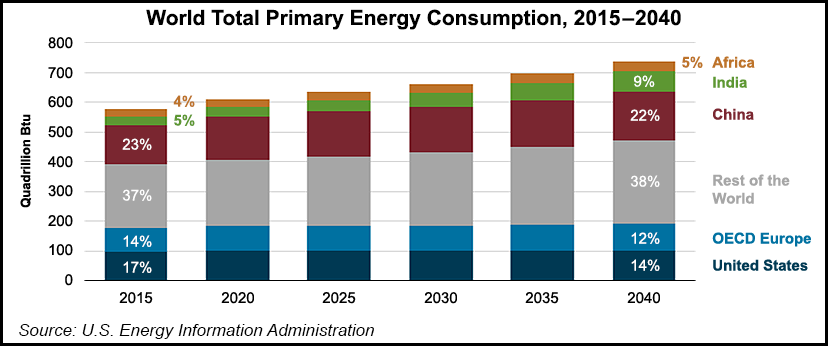Markets | E&P | LNG | NGI The Weekly Gas Market Report
Energy Use By China, India, Africa Forecast to Surge Through 2040, Says EIA
Energy consumption rates for China, India and Africa, the three most populous places on the globe, are projected to grow faster than the rest of the world through 2040 and pose “significant implications for global energy markets,” according to the U.S. Energy Information Administration (EIA).

While the economies of China, India and Africa collectively accounted for 32% of global energy consumption in 2015, the consumption rate is projected to increase to 36% by 2040. The projections were included in three reports EIA issued Tuesday as part of its International Energy Outlook 2018 (IEO2018).
“The work presented in IEO2018 is an important step to better understanding the effects of different patterns of economic growth on China, India, and Africa, as well as improving EIA’s international modeling capabilities,” said Administrator Linda Capuano.
EIA tested three high-economic growth cases for India, two for China and one for Africa. China reportedly used 132.6 quadrillion Btu of energy in 2015, followed by India (28.6 quadrillion Btu) and Africa (22.7 quadrillion Btu).
India is projected to have the world’s largest population by 2025 and the fastest-growing economy, but its energy usage will not reach the levels of China or the United States over the next two decades, EIA said. In one of the three case studies, where exports accounted for 55% of India’s economy by 2040, energy consumption is projected to increase 30.4% (to 90.5 quadrillion Btu) over the IEO2018 reference case (69.4 quadrillion Btu).
China is expected to remain by far the world’s largest producer of energy-intensive goods in 2040. However, EIA said it’s unclear how quickly, or even if, China will transition from a manufacturing economy supported by investment- and export-led growth to a service-oriented economy that’s geared toward personal consumption-led growth. If Beijing transitions quickly to personal consumption-led growth, it would account for 60% of China’s economy by 2040 (193.3 quadrillion Btu), compared with 50% in the IEO2018 reference case (162.2 quadrillion Btu).
The African continent has the potential for rapid economic growth because of its vast natural resources and a population that is younger and faster-growing than many other parts of the world, EIA said. Under a high economic growth scenario, Africa’s manufacturing and industrial sectors would expand and energy consumption per capita would be 43.6 quadrillion Btu, 25% higher than the IEO2018 reference case (34.8 quadrillion Btu).
China and India are expected to be large consumers of natural gas in the future, in part fueled by U.S. exports. Last month, the International Energy Agency (IEA) reported that China’s demand for natural gas is expected to grow 60% between 2017 and 2023. Meanwhile, BP plc reported in February that under one scenario, the United States would account for almost 25% of global gas production by 2040 and, with Qatar, would account for almost half of global liquefied natural gas (LNG) exports.
IEA also reported in January that China and India are projected to have the largest expansions into renewable energy in the coming decades. The global energy watchdog predicted that the United States would become the world’s largest LNG exporter by the mid-2020s.
© 2024 Natural Gas Intelligence. All rights reserved.
ISSN © 1532-1231 | ISSN © 1532-1266 |
